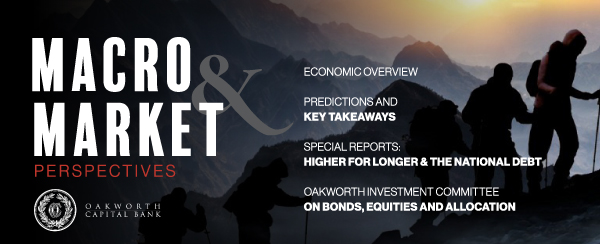The phrase “higher for longer” is getting a lot of air time and press lately. What exactly does it mean? Why now? and How will it affect the economy and financial markets going forward?
What it means: the Federal Reserve will be forced to keep the fed funds rate at a higher level, for longer than most economists were expecting.
How this impacts us: This will keep borrowing costs elevated for both consumers and businesses. Everything from mortgage loans to credit card balances become more expensive.
Why now: The Fed only has two mandates:
1) maximum employment and 2) price stability. The maximum employment part is easy to understand, but what exactly does price stability mean?
How this impacts us: In the eyes of the Fed, this means keeping core inflation at (or near) their target of 2%.
INFLATION
So far this year, inflation has been falling rapidly. Is this not enough for the Fed to start to bring interest rates down? Headline Consumer Price Index (CPI) inflation has fallen from just over 9% last summer to a current level of 3.67%. The other main inflation gauge, Personal Consumption Expenditures (PCE), has fallen a similar amount.
These are “headline” inflation numbers, and they can be dominated by two things: changing energy and food prices. No doubt everyone spends their hard-earned cash on both energy and food, but these prices can also be extremely volatile. The Fed wants to have a look at a more stable price indicator, so they strip out energy and food prices to have a more stable inflation gauge to aid their longer-term planning. This is called core inflation, and these are the inflation numbers that the Fed places more weight in to see if prices are rising near their 2% target.
As you can see, the core inflation numbers did not climb to the same heights that the headline inflation numbers, but have also remained higher than the headline numbers. The Fed wants these numbers to drop to 2%, and this may require more time. Put another way, higher for longer.
CORE INFLATION = Change in price of all goods and services – Change in price of energy and food
CORE INFLATION
HIGHER INTEREST RATES
Why would the Federal Reserve want to make it more expensive to borrow money? Higher interest rates slow down the economy and bring elevated core inf lation numbers down to their target of 2%.
- Corporations tend not to grow as quickly (or hire as many people) with higher interest rates.
- Consumers tend to borrow and spend less with higher interest
CONSUMER SPENDING
The Fed has been raising interest rates for some time now, so why has consumer spending remained so strong? The next chart may give us an answer to that question. When COVID hit, just about everyone who could work from home did. There was very little eating out, very few vacations and far less need to fill up the tank and drive anywhere. The average personal savings rate for the consumer jumped from an average of 7% all the way to a peak of 26.4% in the summer of 2020. As the economy slowly reopened, that savings rate started to decline. That rate bottomed at just over 3% last summer, and has only recently started to come back to a more normal level.
PERSONAL SAVINGS RATE
So why did higher interest rates not slow down the consumer over the past 15 months? The answer is consumers have been spending saved money, not borrowed money. That saved cash is just about gone, and now the higher borrowing rates should start to have more of an impact on consumer spending. We are seeing credit card debt start to expand, and the consumer is starting to change how, and where, they are spending their money.
As long as inflation was in check, the Fed could do whatever they needed to in order to have maximum employment.
THE FEDERAL RESERVE
Over the past 25 years, when we faced an event that was going to have a negative effect on the economy (and the labor market), the Fed has been able to drop interest rates dramatically to help support the economy.
The three most obvious events were:
- The terrorist attacks from Sept. 11, 2001
- The housing/financial collapse of 2008
- The onset of the COVID-19 pandemic in 2020
Each time, the Fed had the ability to drop the fed funds rates dramatically. Why? Because core inflation was at or below their 2% target.
FEDERAL FUNDS RATE
In all three of these situations, there was clear and present economic danger. Inf lation was in check, and there was good reason to be hyper-focused on the slack in the labor market. Fast forward to our current situation – as murky as some economic forecasts are, the current situation is not nearly so shabby.
- Currently the unemployment rate is 8%, which is below many economists’ expectation for what full employment is.
- The Federal Reserve’s recent forecast shows expectation for unemployment to reach 4.5%. In this forecast, and with that unemployment rate, they still did not forecast any rate they still did not forecast any rate cuts.
That leads me to my question: If the Federal Reserve is amenable to unemployment creeping up to 4.5% and not cutting rates, why on earth would they cut rates with inflation still nearly double their target? It’s a hard question to answer. It may (or may not) mean no more hikes, with policy now restrictive by most estimations, however it likely means the Fed is going to be willing to hold policy restrictive for some time. You guessed it, higher for longer.
With core inflation between 4.2% and 4.3%, the Fed will not have the same playbook available to them and, based on their own words, would likely not come into play until unemployment is higher than their own projection. They may be able to lower the fed funds rate some to help ease the pressure, but it is hard to envision dropping that rate to near zero again given the current environment.
CAPITAL MARKETS
Higher interest rates will also have an effect on the capital markets.
The Bond Market
First, as interest rates have moved higher, the bond market is able to provide fixed income investors a higher yield on their investments. All else being equal, you should expect a higher current income from a bond portfolio.
The Stock Market
Higher interest rates for longer can have an opposite effect for equity returns. As borrowing costs increase, corporations will tend to grow at a slower pace than in a lower interest rate environment. The higher costs can also lead to lower profit margins, and lower earnings. That slower growth, both from a company level and slower economic growth, can lead to a stock market with a lower valuation level. A company with a higher growth rate will typically trade with a higher multiple to those earnings, and a slower grower will have a lower valuation.
With bond yields higher and expected stock returns coming down, it would be expected to see investors shift their allocation mix to slightly higher fixed income and lower stock allocation.
THE IMPACT OF HIGHER RATES ON CORPORATIONS AND CONSUMERS
As higher interest rates become the new normal, both corporations and individual consumers will stop waiting for lower rates to make important decisions. If one company is looking to buy another company, for example, they may have been waiting for a lower interest rate environment to make the offer. If rates are not expected to drop much from current levels, a company may just accept the higher borrowing costs to make sure the deal still happens.
The housing market will also adjust to the higher interest rate environment. Those who were able to take advantage of the 3% 30-year mortgage market a few years ago may not look to sell any time soon, so inventory levels may remain lower than normal for an extended period of time. But life changes and families will once again be downsizing, upsizing and moving. A 6% or 7% mortgage rate was the norm 20+ years ago, and it probably will be again.
While “higher for longer” seems to scare investors, there actually can be some positives. Higher interest rates mean a higher bar for what is considered a good investment. It makes sense. Why would I risk my capital for 6% when I can get a guaranteed 5% in a treasury note? The free money of the last several years created an environment that almost rewarded undisciplined investing. Excess risk for a marginal return. This undisciplined environment is not only unsustainable, but also unhealthy.
While it may take a little pain to get there, if getting to the other side means more disciplined capital allocation, it may not be the worst thing.
Welcome to the next “new normal.”
This content is part of our quarterly outlook and overview. For more of our view on this quarter’s economic overview, inflation, bonds, equities and allocation read our entire 3rd Quarter 2023 Macro & Market Perspectives.

The opinions expressed within this report are those of the Investment Committee as of the date published. They are subject to change without notice, and do not necessarily reflect the views of Oakworth Capital Bank, its directors, shareholders or employees.



